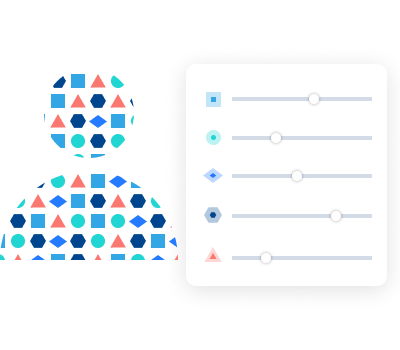The more common the word becomes, the greater the likelihood that a significant difference is summarized in a single world. If enough people regularly exhibit a form of behaviour and no term exists in a given language to describe, according to the lexical hypothesis, a term is a natural outcome.
Two psychologists in the late 1930s, Gordon Allport and Henry Odbert, gathered 18,000 personality-describing words from Webster's New International Dictionary. From this giant list, they found the adjectives that described non-physical characteristics, creating a 4,500 word bank words/observable traits.
In 1946, psychologist Raymond Cattell leveraged the power of one emerging technology to better cluster Allport and Odbert’s list, the computer. With the technology, Cattell generated 181 clusters of personality traits and asked people which ones they observed in the real-world. The analysis and research Cattell generated a sixteen factor framework test which included factors such as intelligence.
In the early 1960s, two researchers from the United States (U.S.) Air Force picked up where Cattell left off. Tupes and Christal created a test, eight large samples, finding five recurring factors. Then in the 1970s two research teams did a massive survey of thousands of people. These teams were from the National Institutes of Health, led by Paul Costa and Robert R. McCrae, and the University of Michigan at Ann Arbor and the University of Oregon, led by Lewis Goldberg and Warren Norman respectively. Their results were in: personality could be described along five dimensions.
Norman named these factors Surgency, Agreeableness, Conscientiousness, Emotional Stability, and Culture. Robert McCrae and Paul Costa went on to develop the Five-Factor Model (FFM), describing the personality in terms of five broad factors. Psychologist Lewis Goldberg used the term the ‘Big Five’ and developed the International Personality Item Pool (IPIP), the first psychometric test. The latter is an “inventory of descriptive statements relating to each trait".
A 1981 symposium in Honolulu gathered the world’s most prominent psychologists in the field to examine the personality model proposed. They concluded the Big 5 model was the most robust model of personality and an astute psychometric test. Research reveals that 80% of personality variance can be observed along the Big 5’s dimensions.
The the Big Five is the only psychometric test and personality model to gather scientific consensus in personality psychology. This is what it sets it apart from other types of psychometric tests.

About the test itself
The Big 5’s origins developed from the massive lexical research program by Allport and Odbert. Their descriptive "theory" was that human beings notice individual personality differences. Since humans notice these differences they would coin a word for those traits.
The lexical program simply measured how people use these words to describe one another with ordinary language. The Big 5 questionnaire evolved to be the measurement tool for this scientific theory. The questionnaire is based on these lexical factors.
Then, Goldberg recommended assessing personality with short phrases rather than individual trait words. This became the format of items for the Big 5 questionnaire, employing short phrases or sentences to assess an individual’s personality.
Thankfully, we possess access to this impactful, psychometric test. The five-factor test includes a number of different exercises, including the self-reporting questionnaire.
The test taker is asked to read a number of descriptions or adjectives and then to rate the accuracy of those descriptions pertaining to their own personality on a Likert scale (e.g. 1 - Strongly Disagree to 2 - Strongly Agree).
Unless a time-intensive behavioral observation is performed, psychometric testing provides a view into a person’s personality that would not otherwise be possible. The downside to this kind of test is that is maybe manipulated, giving answers that may seem better than others. Of course, psychologists have a term for this, social desirability bias.
Results from these psychometric tests are based on comparing them to other humans who have also taken the test. Men are compared with other men’s results; women are compared with other women.
Who uses psychometric testing?
Every type of organization, big and small, leverages the Big 5 to help them understand their students, colleagues, and employees better. "A lot of companies use this (test) for hiring decisions or for allocation of different workers to different types of tasks," Karen Macours of the Paris School of Economics tells National Press Review (NPR). It simplifies and informs the selection process and any forthcoming interview.
Organizations like the World Bank use the online test to ascertain what skills employers are looking for and what kinds of skills the local population has, using it to deduce education and skill level.
What are the 5 dimensions of personality?

1- Openness to experience
Think of those people who have a willingness to try new activities or who are open to unconventional, new ideas. This dimension expressed in the willingness to try out the unknown. Traveling to new places and visiting new cultures are a few indicators of a person more “open”. Those who have low levels are generally skeptical about the unknown and questioning the status quo.
2- Conscientiousness
This personality trait found in the Five Factor Personality Model examines impulse control. Individuals who are more conscientious on this particular facet of the personality scale are able to control impulse. They’re the classmates who tend to organize their class assignments by color; the co-workers who use a desk calendar in addition to their online calendar and journal calendar.
3- Extraversion-Introversion
This dimension refers to how people gain their energy. Extroverts to gain energy from activities and people. Introverts prefer the world of ideas and internal thoughts. Extroverts possess the special ability to advance projects quickly. Introvert’s special skills include picking up the moving dynamics of a particular situation.
4- Agreeableness
Agreeable individuals take a rather maternal and a more cooperative approach to situations. They care deeply about people, more so than themselves. They are far more likely to consider and incorporate the feelings of others in decisions. Those who score low in agreeableness are viewed as “competitive”.
5- Neuroticism
Neuroticism refers to the emotional stability a person has. If they tend to be emotionally stable ---meaning their moods tend to stay pretty constant--- they would be termed as “low neuroticism”. If their moods and feelings fluctuate over a period of time, they are labeled with “high neuroticism”.
How does the Big 5 relate to hiring and recruitment?

Knowing and understanding an individual’s personality is not only beneficial to them, but answers how organizations equip themselves with talent. The challenge in identifying and finding the most qualified candidates is significant. According to a survey from the Society for Human Resource Management, nearly 20% of employers say they use some type of personality test as part of the hiring process.
In a study published by psychologists Paul R. Sackett and Philip T. Walmsley of the University of Minnesota, large data sets of hiring and job performance information were analyzed to find out which personality attributes organizations prioritized. Much of the data stemmed from an analysis of structured job interviews, understanding what traits employers were looking for. From verbal reasoning tests to numerical reasoning tests, Sackett and Walmsley found one of the Big 5 dimensions is the sought-after: conscientiousness.
When an employee is conscientious, they’re dependable, orderly, and persevering. The second most valued attribute was agreeableness, the ability to be cooperative, flexible, and work well with others. The psychologists summarized their study, “Our findings provide robust evidence that attributes related to Conscientiousness and Agreeableness are highly important for workforce readiness across a variety of occupations that require a variety of training and experience qualifications”.
The researchers examined the 3 key areas employers value in job performance:
- whether an employee is able to complete their work to satisfaction
- how often an employee goes above and beyond at work
- how often they engage in negative behaviors.
Companies use online pre-employment assessments as a proactive, forward-looking hiring approach. Applicants are not lines on a resume. Instead assessments like the Big 5 model give recruiters more metrics surrounding a candidate. These kinds of aptitude tests share valuable information and come in the form of 3 kinds:
- Competencies (like psychometric assessments)
- Cognitive ability
- Personality
These kinds of multi-dimensional approaches to predict gauge abstract reasoning, employee performance, cognitive ability, and social intelligence within a group. When taking a psychometric test, applicants fill out a set of questions. These are used to identify patterns and relationships which reveal how candidates approach a problem. Situational intelligence reveals an applicant’s aptitude for Agreeableness, which can better ascertain their people skills. Technology is used to upgrade the efficacy of this psychometrist test.
Initially, a simple algorithm checked if questions were answered in a specific pattern. With AI, online personality assessments are infused with rapid, predictive capabilities. Algorithms powered by artificial intelligence can better estimate psychometric tests, estimating an applicant's fit within a job description, within a company’s values, and how they might be a credit to the team. AI can rapidly combine several variables for hiring managers, which save them value time in finding top talent.
AI defends recruiters' time
HR professionals are challenged by a myriad of different needs---which online job boards and channels to find the exact fit, how to quickly sift through the mass of applicants, schedule in-person and video interviews, and how to successfully onboard. There is a crucial need for speed and efficiency. They’re not only looking on how to gather talent and hire into their organization. But additionally how the long-term commitment and success of an employee. Hiring professionals may not feel supported in their efforts to find new talent, but also develop their internal employees. Its ability to centralize information and manage applicants and employees means recruiters can move faster in whichever direction they choose. AI is not a panacea for the talent management lifecycle. But it can add value to the work life of a recruiter.
AI can support recruiters in Identifying and hiring the best fit
With the speed of AI to sort through thousands of applications, it’s similar to seasoned HR professionals going through applications to pick the most qualified candidates. Additionally, with both professionals and technology, there lies two lines of defense in making a wrong hire. According to Undercover Recruiter, the cost of a bad hire can reach up to 30% of the employee's first-year earnings. Leadership IQ found that 46% of newly-hired employees will be deemed failures within 18 months after starting.
The cost of an employer-employee mismatch can be calculated by:
- Time spent on hiring activities
- Cost of recruitment marketing
- Revenue per employee
Making a bad hire keeps recruiters and managers up at night. 74% of companies who admit they've hired the wrong person for a position lost an average of $14,900 for each bad hire. AI can support this part of the talent lifecycle by adding extra measures and extra efficiency in how candidates are screened. Also this means more sleep for recruiters, making AI a win-win.
Create a more transparent recruitment process
When Alexander Pope wrote “To err is human”, he could have very well been talking about contemporary hiring practices. The fact is we humans possess biases--often we’re unaware we hold certain biases. Just as AI supports in screening candidates by using both technology and humans to find the best fit, AI adds another layer to support fair hiring practices. The technology proved how it could prevent bias in hiring as far back as 1988.
The UK Commission for Racial Equality found a British medical school guilty of discrimination. The school’s computer program, which helped the admissions team find the best applicants, was found out to be biased against women and those with non-European names. The program was developed to adhere to the admission team’s decision-making history.
The computer program was deemed a success as it showed a 90 percent accuracy. Though a complete failure in creating an equal admissions decision, the medical school did admit more non-European students than other medical schools. Human bias was clearly programmed into the software, but the technology did add in another layer of diversity.
Hiring practices involving both AI and humans is part of a new system: “human-in-the-loop”, where recommendations are made by an AI program and options are provided so that provide recruiters can double-check. The interplay creates a more transparent and systematic approach to how decisions are made. Confidence from both employers and applicants will arise knowing applications are treated with fairness.
Evaluate the state of the talent pool
With a psychometrics test, recruiters possess the answers on data surrounding employees competencies, skill sets, cognitive abilities, and personal needs. Additionally, with a psychometric test, they have a holistic overview of the entire candidate hiring pool. This can help with areas such as succession planning and scouting for executives.
With more data, recruiters can understand trends in skills and job performance, planning for it with ample time. Talent recruitment pools are often the most ignored aspect of hiring as it takes time and information.
Powered by the “human-AI feedback loop” the likelihood of making a hiring mistake decreases. The modern candidate decision-making process has stagnated, leaving ample room for error---leaving “money on the table” in terms of learning about the candidates and industry.
Eric Feng, a partner at Kleiner Perkins Caufield & Byers, said “Only 25% of the workforce is actively looking at any given time, but 85% is willing to talk.” Recruiters can use AI to target candidates that are willing to discuss new opportunities based on variables such as new skills, region, job title and number of years having worked under the same title.
Using the Big 5, AI can support hiring professionals better understand applicants in a more holistic and more human manner. AI holds the potential to positively impact how businesses approach their talent management lifecycle, from the candidate experience to onboarding. By measuring and developing better insight into the individual differences in personality, hiring recruiters can create a transparent and human-centric recruitment strategy.
If you're looking to improve your team's skills and provide them with personalized coaching, consider trying out Retorio today!





